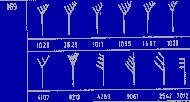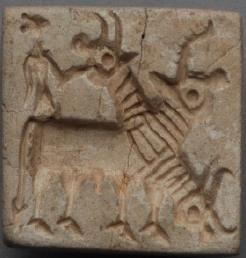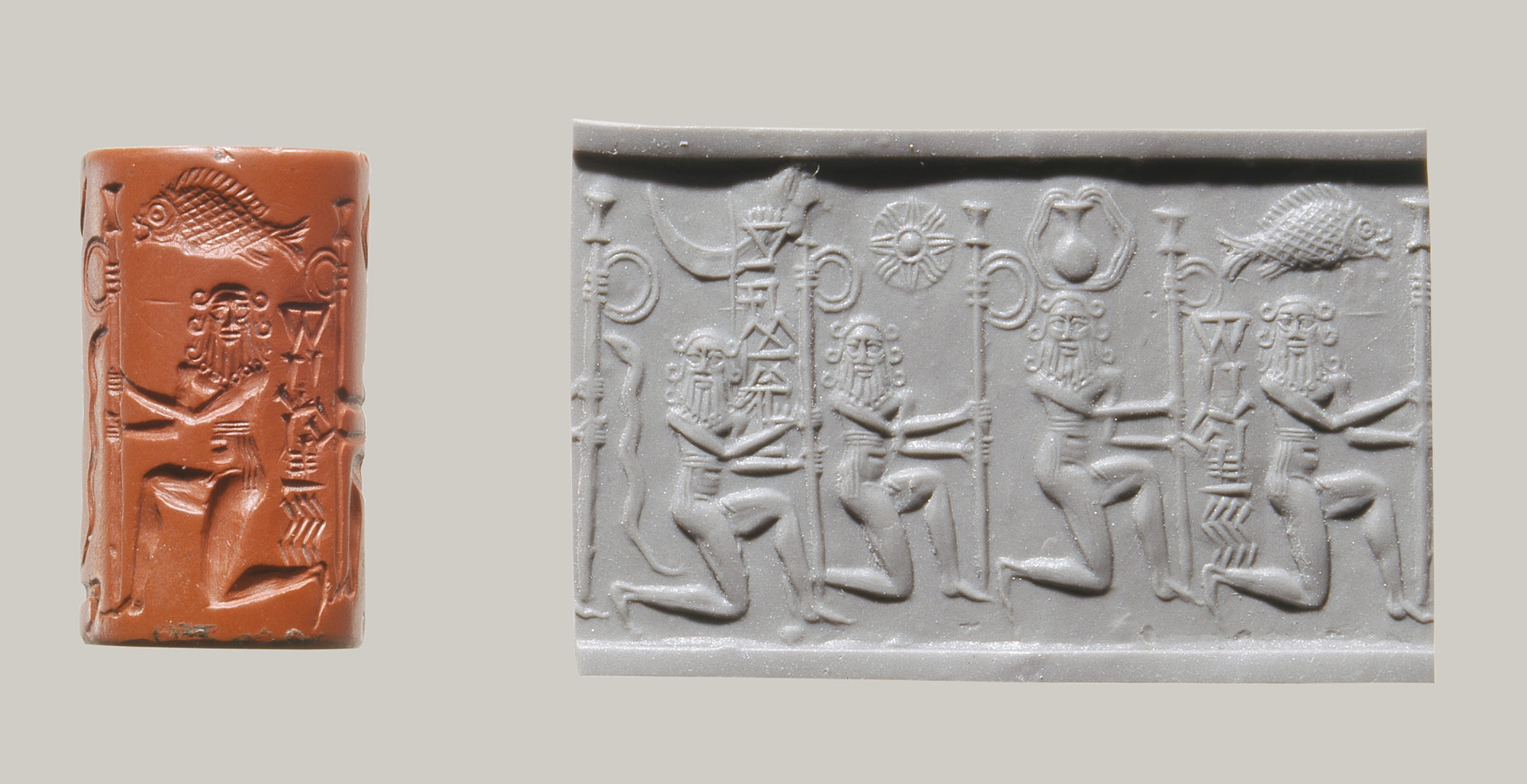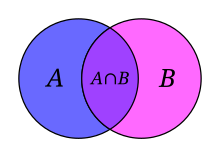Mirror: http://tinyurl.com/o2wbxrh
Orthographic variants of tails of 'animal' hieroglyphs, particularly those of ram or antelope are deciphered as rebus-metonymy layered Meluhha (Proto-Prakritam) words related to blacksmithy or smelters of iron and other metals including metal infusion and cire perdue lost-wax castings. The 'tail' hieroglyh also gets normalised as a sign on texts to connote kolA 'tail' Rebus: kolhe 'smelter' kolle 'blacksmith'.
Some hieroglyph components are: hooded snake or short-tail generally on antelopes.
 This hieroglyph appears on Jasper Akkadian cylinder seal. kulā hood of snake Rebus: kolle'blacksmith'
This hieroglyph appears on Jasper Akkadian cylinder seal. kulā hood of snake Rebus: kolle'blacksmith'One Proto-Prakritam word signifies both 'tail' and 'hood of serpent'. The word is: xolā 'tail' of antelope and kulā hooded snake as tail. A similar sounding word signifies a blacksmith or smelter: kolle 'blacksmith' kolhe 'smelter'. These can be cited as 'signature' tunes of the writing system, to convey the semantics of a metalworker -- a smith or a smelter.
The hieroglyph component in hieroglyph-multiplex pictorial motifs also gets normalised as a 'sign' on texts of inscriptions. See Sign 169 (Mahadevan Concordance).
 Variants of Sign 169 (Mahadevan concordance) Comparable hieroglyph components constitute the 'tail' of antelopes on Indus Script Corpora. This is an example of a 'sign' becoming a component of a 'pictorial motif' thus creating a hieroglyph-multiplex (hypertext).
Variants of Sign 169 (Mahadevan concordance) Comparable hieroglyph components constitute the 'tail' of antelopes on Indus Script Corpora. This is an example of a 'sign' becoming a component of a 'pictorial motif' thus creating a hieroglyph-multiplex (hypertext).Hieroglyph: hood of a snake: kulā ʻhood of a snake' (Assamese)kulya n. ʻ receptacle for burnt bones of a corpse ʼ MBh., ʻ winnowing basket ʼ lex. [Prob. ← Drav.: see kulāˊya -- ]Pa. kulla -- m. ʻ raft of basket work, winnowing basket ʼ, °aka -- m. ʻ crate ʼ; Pk. kullaḍa -- n. ʻ packet ʼ; A. kulā ʻ winnowing fan; B. kul, °lā ʻ winnowing basket or fan ʼ; Or. kulā ʻ winnowing fan ʼ, °lāi ʻ small do. ʼ; Si. kulla, st. kulu -- ʻ winnowing basket or fan ʼ.(CDIAL 3350)
 m0492Ct
m0492Ct ![clip_image057[4]](http://kalyan97.files.wordpress.com/2007/06/clip-image0574-thumb.jpg?w=80&h=68) 2835 Pict-99: Person throwing a spear at a bison and placing one foot on the head of the bison; a hooded serpent at left.
2835 Pict-99: Person throwing a spear at a bison and placing one foot on the head of the bison; a hooded serpent at left.Mohenjodaro seal (m0302).
The composite animal glyph is one example to show that rebus method has to be applied to every glyphic element in the writing system.
This image is also interpreted in corpora (e.g. Mahadevan's Corpus of Indus script) as: body of a ram, horns of a bison, trunk of elephant, hindlegs of a tiger and an upraised serpent-like tail.


 m1186, m301, m302, m300
m1186, m301, m302, m300Mohenjodaro seals shows a 'composite animal' hieroglyph-muliplex, hypertext composition.
Ligatured faces: some close-up images.
The animal is a quadruped: pasaramu, pasalamu = an animal, a beast, a brute, quadruped (Te.)Rebus: pasra ‘smithy’ (Santali) Allograph: panǰā́r ‘ladder, stairs’(Bshk.)(CDIAL 7760) Thus the composite animal connotes a smithy. Details of the smithy are described orthographically by the glyphic elements of the composition.
Rebus reading of the 'face' glyph: mũhe ‘face’ (Santali) mũh opening or hole (in a stove for stoking (Bi.); ingot (Santali)mũh metal ingot (Santali) mũhã̄ = the quantity of iron produced at one time in a native smelting furnace of the Kolhes; iron produced by the Kolhes and formed like a four-cornered piece a little pointed at each end; mūhā mẽṛhẽt = iron smelted by the Kolhes and formed into an equilateral lump a little pointed at each of four ends; kolhe tehen mẽṛhẽt ko mūhā akata = the Kolhes have to-day produced pig iron (Santali.lex.) kaula mengro ‘blacksmith’ (Gypsy) mleccha-mukha (Skt.) = milakkhu ‘copper’ (Pali) The Sanskrit loss mleccha-mukha should literally mean: copper-ingot absorbing the Santali gloss, mũh, as a suffix.
A remarkable phrase in Sanskrit indicates the link between mleccha and use of camels as trade caravans. This is explained in the lexicon of Apte for the lexeme: auṣṭrika 'belonging to a camel'. The lexicon entry cited Mahābhārata: औष्ट्रिक a. Coming from a camel (as milk); Mb.8. 44.28; -कः An oil-miller; मानुषाणां मलं म्लेच्छा म्लेच्छाना- मौष्ट्रिका मलम् । औष्ट्रिकाणां मलं षण्ढाः षण्ढानां राजयाजकाः ॥ Mb.8.45.25. From the perspective of a person devoted to śāstra and rigid disciplined life, Baudhāyana thus defines the word म्लेच्छः mlēcchḥ : -- गोमांसखादको यस्तु विरुद्धं बहु भाषते । सर्वाचारविहीनश्च म्लेच्छ इत्यभिधीयते ॥ 'A person who eatrs meat, deviates from traditional practices.'
The 'face' glyph is thus read rebus: mleccha mũh 'copper ingot'.
It is significant that Vatsyayana refers to crptography in his lists of 64 arts and calls it mlecchita-vikalpa, lit. 'an alternative representation -- in cryptography or cipher -- of mleccha words.'
The glyphic of the hieroglyph: tail (serpent), face (human), horns (bos indicus, zebu or ram), trunk (elephant), front paw (tiger):
The animal is a quadruped: pasaramu, pasalamu = an animal, a beast, a brute, quadruped (Te.)Rebus: pasra ‘smithy’ (Santali) Allograph: panǰā́r ‘ladder, stairs’(Bshk.)(CDIAL 7760) Thus the composite animal connotes a smithy. Details of the smithy are described orthographically by the glyphic elements of the composition.
Rebus reading of the 'face' glyph: mũhe ‘face’ (Santali) mũh opening or hole (in a stove for stoking (Bi.); ingot (Santali)mũh metal ingot (Santali) mũhã̄ = the quantity of iron produced at one time in a native smelting furnace of the Kolhes; iron produced by the Kolhes and formed like a four-cornered piece a little pointed at each end; mūhā mẽṛhẽt = iron smelted by the Kolhes and formed into an equilateral lump a little pointed at each of four ends; kolhe tehen mẽṛhẽt ko mūhā akata = the Kolhes have to-day produced pig iron (Santali.lex.) kaula mengro ‘blacksmith’ (Gypsy) mleccha-mukha (Skt.) = milakkhu ‘copper’ (Pali) The Sanskrit loss mleccha-mukha should literally mean: copper-ingot absorbing the Santali gloss, mũh, as a suffix.
A remarkable phrase in Sanskrit indicates the link between mleccha and use of camels as trade caravans. This is explained in the lexicon of Apte for the lexeme: auṣṭrika 'belonging to a camel'. The lexicon entry cited Mahābhārata: औष्ट्रिक a. Coming from a camel (as milk); Mb.8. 44.28; -कः An oil-miller; मानुषाणां मलं म्लेच्छा म्लेच्छाना- मौष्ट्रिका मलम् । औष्ट्रिकाणां मलं षण्ढाः षण्ढानां राजयाजकाः ॥ Mb.8.45.25. From the perspective of a person devoted to śāstra and rigid disciplined life, Baudhāyana thus defines the word म्लेच्छः mlēcchḥ : -- गोमांसखादको यस्तु विरुद्धं बहु भाषते । सर्वाचारविहीनश्च म्लेच्छ इत्यभिधीयते ॥ 'A person who eatrs meat, deviates from traditional practices.'
The 'face' glyph is thus read rebus: mleccha mũh 'copper ingot'.
It is significant that Vatsyayana refers to crptography in his lists of 64 arts and calls it mlecchita-vikalpa, lit. 'an alternative representation -- in cryptography or cipher -- of mleccha words.'
The glyphic of the hieroglyph: tail (serpent), face (human), horns (bos indicus, zebu or ram), trunk (elephant), front paw (tiger):
poLa 'bos indicus, zebu' Rebus: poLa 'magnetite'
karibha 'trunk of elephant' (Pali) ibha 'elephant' (Samskritam) Rebus: karba 'iron' (Ka.)(DEDR 1278) as in ajirda karba 'iron' (Ka.) kari, karu 'black' (Ma.)(DEDR 1278) karbura 'gold' (Ka.) karbon 'black gold, iron' (Ka.) kabbiṇa 'iron' (Ka.) karum pon 'iron' (Ta.); kabin 'iron' (Ko.)(DEDR 1278) Ib 'iron' (Santali) [cf. Toda gloss below: ib ‘needle’.] Ta. Irumpu iron, instrument, weapon. a. irumpu,irimpu iron. Ko. ibid. To. Ib needle. Koḍ. Irïmbï iron. Te. Inumu id. Kol. (Kin.) inum (pl. inmul)iron, sword. Kui (Friend-Pereira) rumba vaḍi ironstone (for vaḍi, see 5285). (DEDR 486) Allograph: karibha -- m. ʻ Ficus religiosa (?) [Semantics of ficus religiosa may be relatable to homonyms used to denote both the sacred tree and rebus gloss: loa, ficus (Santali); loh ‘metal’ (Skt.)]
miṇḍāl markhor (Tor.wali) meḍho a ram, a sheep (G.)(CDIAL 10120)bhēḍra -- , bhēṇḍa -- m. ʻ ram ʼ lex. [← Austro -- as. J. Przyluski BSL xxx 200: perh. Austro -- as. *mēḍra ~ bhēḍra collides with Aryan mḗḍhra -- 1 in mēṇḍhra -- m. ʻ penis ʼ BhP., ʻ ram ʼ lex. -- See also bhēḍa -- 1, mēṣá -- , ēḍa -- . -- The similarity between bhēḍa -- 1, bhēḍra -- , bhēṇḍa -- ʻ ram ʼ and *bhēḍa -- 2 ʻ defective ʼ is paralleled by that between mḗḍhra -- 1, mēṇḍha -- 1 ʻ ram ʼ and *mēṇḍa -- 1, *mēṇḍha -- 2 (s.v. *miḍḍa -- ) ʻ defective ʼ](CDIAL 9606) mēṣá m. ʻ ram ʼ, °ṣīˊ -- f. ʻ ewe ʼ RV. 2. mēha -- 2, miha- m. lex. [mēha -- 2 infl. by mḗhati ʻ emits semen ʼ as poss. mēḍhra -- 2 ʻ ram ʼ (~ mēṇḍha -- 2) by mḗḍhra -- 1 ʻ penis ʼ?]1. Pk. mēsa -- m. ʻ sheep ʼ, Ash. mišalá; Kt. məṣe/l ʻ ram ʼ; Pr. məṣé ʻ ram, oorial ʼ; Kal. meṣ, meṣalák ʻ ram ʼ, H. mes m.; -- X bhēḍra -- q.v.2. K. myã̄ -- pūtu m. ʻ the young of sheep or goats ʼ; WPah.bhal. me\i f. ʻ wild goat ʼ; H. meh m. ʻ ram ʼ.mēṣāsya -- ʻ sheep -- faced ʼ Suśr. [mēṣá -- , āsyà -- ](CDIAL 10334) Rebus: meḍ (Ho.); mẽṛhet ‘iron’ (Mu.Ho.)mẽṛh t iron; ispat m. = steel; dul m. = cast iron (Mu.) Allograph: meḍ ‘body ' (Mu.)
miṇḍāl markhor (Tor.wali) meḍho a ram, a sheep (G.)(CDIAL 10120)bhēḍra -- , bhēṇḍa -- m. ʻ ram ʼ lex. [← Austro -- as. J. Przyluski BSL xxx 200: perh. Austro -- as. *mēḍra ~ bhēḍra collides with Aryan mḗḍhra -- 1 in mēṇḍhra -- m. ʻ penis ʼ BhP., ʻ ram ʼ lex. -- See also bhēḍa -- 1, mēṣá -- , ēḍa -- . -- The similarity between bhēḍa -- 1, bhēḍra -- , bhēṇḍa -- ʻ ram ʼ and *bhēḍa -- 2 ʻ defective ʼ is paralleled by that between mḗḍhra -- 1, mēṇḍha -- 1 ʻ ram ʼ and *mēṇḍa -- 1, *mēṇḍha -- 2 (s.v. *miḍḍa -- ) ʻ defective ʼ](CDIAL 9606) mēṣá m. ʻ ram ʼ, °ṣīˊ -- f. ʻ ewe ʼ RV. 2. mēha -- 2, miha- m. lex. [mēha -- 2 infl. by mḗhati ʻ emits semen ʼ as poss. mēḍhra -- 2 ʻ ram ʼ (~ mēṇḍha -- 2) by mḗḍhra -- 1 ʻ penis ʼ?]1. Pk. mēsa -- m. ʻ sheep ʼ, Ash. mišalá; Kt. məṣe/l ʻ ram ʼ; Pr. məṣé ʻ ram, oorial ʼ; Kal. meṣ, meṣalák ʻ ram ʼ, H. mes m.; -- X bhēḍra -- q.v.2. K. myã̄ -- pūtu m. ʻ the young of sheep or goats ʼ; WPah.bhal. me\i f. ʻ wild goat ʼ; H. meh m. ʻ ram ʼ.mēṣāsya -- ʻ sheep -- faced ʼ Suśr. [mēṣá -- , āsyà -- ](CDIAL 10334) Rebus: meḍ (Ho.); mẽṛhet ‘iron’ (Mu.Ho.)mẽṛh t iron; ispat m. = steel; dul m. = cast iron (Mu.) Allograph: meḍ ‘body ' (Mu.)
The glyphic elements of the composite animal shown together with the glyphs of fish, fish ligatured with lid, arrow (on Seal m0302) are:
--ram or sheep (forelegs denote a bovine)
--neck-band, ring
--bos indicus (zebu)(the high horns denote a bos indicus)
--elephant (the elephant's trunk ligatured to human face)
--tiger (hind legs denote a tiger)
--serpent (tail denotes a serpent)
--human face
All these glyphic elements are decoded rebus:
meḍho a ram, a sheep (G.)(CDIAL 10120);
kaḍum ‘neck-band, ring’
adar ḍangra ‘zebu’
ibha ‘elephant’ (Skt.); rebus: ib ‘iron’ (Ko.)
kolo ‘jackal’ (Kon.)
mũhe ‘face’ (Santali); mleccha-mukha (Skt.) = milakkhu ‘copper’ (Pali)
கோடு kōṭu : •நடுநிலை நீங்குகை. கோடிறீக் கூற் றம் (நாலடி, 5). 3. [K. kōḍu.] Tusk; யானை பன்றிகளின் தந்தம். மத்த யானையின் கோடும் (தேவா. 39, 1). 4. Horn; விலங்கின் கொம்பு. கோட்டிடை யாடினை கூத்து (திவ். இயற். திருவிருத். 21). Ta. kōṭu (in cpds. kōṭṭu-) horn, tusk, branch of tree, cluster, bunch, coil of hair, line, diagram, bank of stream or pool; kuvaṭu branch of a tree; kōṭṭāṉ, kōṭṭuvāṉ rock horned-owl (cf. 1657 Ta. kuṭiñai). Ko. kṛ (obl. kṭ-) horns (one horn is kob), half of hair on each side of parting, side in game, log, section of bamboo used as fuel, line marked out. To. kwṛ (obl. kwṭ-) horn, branch, path across stream in thicket. Ka. kōḍu horn, tusk, branch of a tree; kōr̤ horn. Tu. kōḍů, kōḍu horn. Te. kōḍu rivulet, branch of a river. Pa. kōḍ (pl. kōḍul) horn (DEDR 2200)
meḍ ‘iron’ (Ho.)
khāḍ ‘trench, firepit’
aduru ‘native metal’ (Ka.) ḍhangar ‘blacksmith’ (H.)
kol ‘furnace, forge’ (Kuwi) kol ‘alloy of five metals, pancaloha’ (Ta.)
mẽṛhẽt, meḍ ‘iron’ (Mu.Ho.)
mūhā mẽṛhẽt = iron smelted by the Kolhes and formed into an equilateral lump a little pointed at each of four ends (Santali)
koḍ = the place where artisans work (G.)
Orthographically, the glytic compositions add on the characteristic short tail as a hieroglyph (on both ligatured signs and on pictorial motifs)
xolā = tail (Kur.); qoli id. (Malt.)(DEDr 2135). Rebus: kol ‘pañcalōha’ (Ta.)கொல் kol, n. 1. Iron; இரும்பு. மின் வெள்ளி பொன் கொல்லெனச் சொல்லும் (தக்கயாகப். 550). 2. Metal; உலோகம். (நாமதீப. 318.) கொல்லன் kollaṉ, n. < T. golla. Custodian of treasure; கஜானாக்காரன். (P. T. L.) கொல்லிச்சி kollicci, n. Fem. of கொல்லன். Woman of the blacksmith caste; கொல்லச் சாதிப் பெண். (யாழ். அக.) The gloss kollicci is notable. It clearly evidences that kol was a blacksmith. kola ‘blacksmith’ (Ka.); Koḍ. kollë blacksmith (DEDR 2133). Vikalpa:dumba दुम्ब or (El.) duma दुम । पशुपुच्छः m. the tail of an animal. (Kashmiri) Rebus: ḍōmba ?Gypsy (CDIAL 5570).
A remarkable evidence is provided by a lexeme in Kota. The lexeme is: kole.l ‘smithy, temple’ (Kota) kwala·l Kota smithy (Toda)kol ‘working in iron, blacksmith (Tamil)(DEDR 2133)Ta. kol working in iron, blacksmith; kollaṉ blacksmith. Ma. kollan blacksmith, artificer. Ko. kole·l smithy, temple in Kota village. To. kwala·l Kota smithy. Ka. kolime, kolume, kulame, kulime, kulume, kulme fire-pit, furnace; (Bell.; U.P.U.) konimi blacksmith; (Gowda) kolla id. Koḍ. kollë blacksmith. Te. kolimi furnace. Go. (SR.) kollusānā to mend implements; (Ph.) kolstānā, kulsānā to forge; (Tr.) kōlstānā to repair (of ploughshares); (SR.) kolmi smithy (Voc. 948). Kuwi (F.) kolhali to forge. (DEDR 2133).
kula कुल (Monier-Williams lexicon): (with शाक्तs) N. of शक्ति and of the rites observed in her worship (cf. कौल); m. the chief of a corporation or guild.
kolma = a paddy plant (Santali) Rebus: kolime= furnace (Ka.)
kolom = cutting, graft; to graft, engraft, prune; kolom dare kana = it is a grafted tree; kolom ul = grafted mango; kolom gocena = the cutting has died; kolom kat.hi hor.o = a certain variety of the paddy plant (Santali); kolom (B.); kolom mit = to engraft; kolom porena = the cutting has struck root; kolom kat.hi = a reed pen (Santali.lex.) cf. kolom = a reed, a reed-pen (B.); qalam (Assamese.Hindi); kolma hor.o = a variety of the paddy plant (Desi)(Santali.lex.Bodding) kolom baba = the threshed or unthreshed paddy on the threshing floor; kolom-ba_rum = the weight a man carries in taking the paddy from the threshing floor to his house; kolom = a threshing floor (Mundari); cf. kal.am (Tamil) [Note the twig adoring the head-dress of a horned, standing person]
ku_l.e stump (Ka.) [ku_li = paddy (Pe.)] xo_l = rice-sheaf (Kur.) ko_li = stubble of jo_l.a (Ka.); ko_r.a = sprout (Kui.) ko_le = a stub or stump of corn (Te.)(DEDR 2242). kol.ake, kol.ke, the third crop of rice (Ka.); kolake, kol.ake (Tu.)(DEDR 2154)
Hieroglyph: xolā = tail (Kur.); qoli id. (Malt.)(DEDr 2135). Rebus: kol ‘pañcalōha’ (Ta.) கொல் kol, n. 1. Iron; இரும்பு. மின் வெள்ளி பொன் கொல்லெனச் சொல்லும் (தக்கயாகப். 550). 2. Metal; உலோகம். (நாமதீப. 318.) கொல்² kol Working in iron; கொற்றொழில். Blacksmith; கொல்லன். (Tamil) கொல்லன் kollaṉ, n. < T. golla. Custodian of treasure; கஜானாக்காரன். (P. T. L.) கொல்லிச்சி kollicci, n. Fem. of கொல்லன். Woman of the blacksmith caste; கொல்லச் சாதிப் பெண். (யாழ். அக.) The gloss kollicci is notable. It clearly evidences that kol was a blacksmith. kola ‘blacksmith’ (Ka.); Koḍ. kollë blacksmith (DEDR 2133).
kolo ‘jackal’ (Konkani) kul 'tiger' (Santali); kōlu id. (Te.) kōlupuli = Bengal tiger (Te.)Pk. kolhuya -- , kulha -- m. ʻ jackal ʼ < *kōḍhu -- ; H.kolhā, °lā m. ʻ jackal ʼ, adj. ʻ crafty ʼ; G. kohlũ, °lũ n. ʻ jackal ʼ, M. kolhā, °lā m. krōṣṭŕ̊ ʻ crying ʼ BhP., m. ʻ jackal ʼ RV. = krṓṣṭu -- m. Pāṇ. [√kruś] Pa. koṭṭhu -- , °uka -- and kotthu -- , °uka -- m. ʻ jackal ʼ, Pk. koṭṭhu -- m.; Si. koṭa ʻ jackal ʼ, koṭiya ʻ leopard ʼ GS 42 (CDIAL 3615). कोल्हा [ kōlhā ] कोल्हें [ kōlhēṃ ] A jackal (Marathi) Rebus: kol ‘furnace, forge’ (Kuwi) kol ‘alloy of five metals, pañcaloha’ (Ta.) Allograph: kōla = woman (Nahali) [The ligature of a woman to a tiger is a phonetic determinant; the scribe clearly conveys that the gloss represented is kōla] kola 'tiger' kola 'woman'
kol, kolhe, ‘the koles, an aboriginal tribe if iron smelters speaking a language akin to that of Santals’ (Santali) kolme =furnace (Ka.) kol = pan~calo_ha (fivemetals); kol metal (Ta.lex.) pan~caloha = a metallic alloy containing five metals: copper, brass, tin, lead and iron (Skt.); an alternative list of five metals: gold, silver, copper, tin (lead), and iron (dhātu; Nānārtharatnākara. 82; Man:garāja’s Nighaṇṭu. 498)(Ka.)
Rebus: kol 'working in iron'. Ta. kol working in iron, blacksmith; kollaṉ blacksmith.
Ma. kollan blacksmith, artificer. Ko. kole·l smithy, temple in Kota village. To. kwala·l Kota smithy. Ka.kolime, kolume, kulame, kulime, kulume, kulme fire-pit, furnace; (Bell.; U.P.U.) konimi blacksmith (Gowda) kolla id. Koḍ. kollë
blacksmith. Te. kolimi furnace. Go.(SR.) kollusānā to mend implements; (Ph.) kolstānā, kulsānā to forge; (Tr.) kōlstānā to repair (of ploughshares); (SR.) kolmi smithy (Voc. 948). Kuwi (F.) kolhali to forge(DEDR 2133).
Kalibangan 37, 34
Two Kalibangan seals show an antelope and fish glyphs as the inscription. Mẽḍha ‘antelope’; rebus: ‘iron’ (Ho.) ayo ‘fish’; rebs: ayo ‘metal’ (G.) [These are examples which clearly demonstrate that Indus script is a glyptic writing system and hence, all glyphs and glyptic elements have to be decoded.] miṇḍāl markhor (Tor.wali) meḍho a ram, a sheep (G.)(CDIAL 10120) iron (Ho.) meṛed-bica = iron stone ore, in contrast to bali-bica, iron sand ore (Munda) meḍ ‘iron’. ayo, hako ‘fish’; ãs = scales of fish (Santali) Rebus: aya
‘metal, iron’ (Gujarati); ayah, ayas = metal (Samskritam)
 Copper plate inscription. Antelope. Short tail upturned. Trough in front.
Copper plate inscription. Antelope. Short tail upturned. Trough in front.
Impression of an Indus-style cylinder seal of unknown Near Eastern origin (After Fig. 6 http://www.akhabataku.com/IndusScript.htm) "One of the two anthropomorphic figures carved on this seal wears the horns of water buffalo while sitting on a throne with hoofed legs, surrounded by snakes, fishes and water buffaloes. Copyrighted photo by M. Chuzeville for the Departement des antiquites orientales, Musee du Louvre." (Parpola, 2001)
 Late Harappan Period dish or lid with perforation at edge for hanging or attaching to large jar. It shows a Blackbuck antelope with trefoil design made of combined circle-and-dot motifs, possibly representing stars. It is associated with burial pottery of the Cemetery H period, dating after 1900 BCE. Credit Harappa.com
Late Harappan Period dish or lid with perforation at edge for hanging or attaching to large jar. It shows a Blackbuck antelope with trefoil design made of combined circle-and-dot motifs, possibly representing stars. It is associated with burial pottery of the Cemetery H period, dating after 1900 BCE. Credit Harappa.com Dholavira Seal. 117 antelope; sun motif
Dholavira Seal. 117 antelope; sun motif Dholavira Seal 56 A horned person standing between two branches of a tree, each with three leaves on outer side and one at the top; a devotee kneels, hands touching the ground; R lower side, a goat with outstretched wavy horns, upturned tail. Vertical perforation.
Dholavira Seal 56 A horned person standing between two branches of a tree, each with three leaves on outer side and one at the top; a devotee kneels, hands touching the ground; R lower side, a goat with outstretched wavy horns, upturned tail. Vertical perforation. Dholavira 34 Seal.
Dholavira 34 Seal.Sources for Dholavira inscriptions: http://bharatkalyan97.blogspot.in/2015/04/excavations-at-dholavifra-1989-2005-rs.html
Hieroglyph: arka 'sun' Rebus: arka 'copper' (Kannada) eraka 'moltencast copper'(Tulu)
அருக்கம்¹ arukkam, n. < arka. (நாநார்த்த.) 1. Copper; செம்பு.
அருக்கம்¹ arukkam, n. < arka. (நாநார்த்த.) 1. Copper; செம்பு.
(Tamil) అగసాలి (p. 0023) [ agasāli ] or అగసాలెవాడు agasāli. [Tel.] n. A goldsmith. కంసాలివాడు.(Telugu) Kannada (Kittel lexicon):
Hieroglyph: mlekh 'goat' Rebus: milakkhu 'copper' mleccha 'copper'
Hieroglyph: kolmo 'sprout' Rebus: kolami 'smithy, forge'
Hieroglyph: barad, barat 'ox' Rebus: भरत (p. 603) [ bharata ] n A factitious metal compounded of copper, pewter, tin &c.(Marathi)
Hieroglyph: one-horned young bull: खोंड (p. 216) [ khōṇḍa ] m A young bull, a bullcalf.(Marathi) खोंडरूं [ khōṇḍarūṃ ] n A contemptuous form of खोंडा in the sense of कांबळा -cowl.खोंडा [ khōṇḍā ] m A कांबळा of which one end is formed into a cowl or hood. खोंडी [ khōṇḍī ] f An outspread shovelform sack (as formed temporarily out of a कांबळा , to hold or fend off grain, chaff &c.)
Hieroglyph: kōḍ 'horn' Rebus: kōḍ 'place where artisans work, workshop' কুঁদন, কোঁদন [ kun̐dana, kōn̐dana ] n act of turning (a thing) on a lathe; act of carving (Bengali) कातारी or कांतारी (p. 154) [ kātārī or kāntārī ] m (कातणें ) A turner.(Marathi)
Rebus: खोदकाम [ khōdakāma ] n Sculpture; carved work or work for the carver.
खोदगिरी [ khōdagirī ] f Sculpture, carving, engraving: also sculptured or carved work.खोदणें [ khōdaṇēṃ ] v c & i (Hieroglyph: horn:
Ta. kōṭu (in cpds. kōṭṭu-) horn, tusk, branch of tree, cluster, bunch, coil of hair, line, diagram, bank of stream or pool; kuvaṭu branch of a tree;kōṭṭāṉ, kōṭṭuvāṉ rock horned-owl (cf. 1657 Ta. kuṭiñai). Ko. ko·ṛ (obl. ko·ṭ-) horns (one horn is kob), half of hair on each side of parting, side in game, log, section of bamboo used as fuel, line marked out. To. kw&idieresisside;ṛ (obl. kw&idieresisside;ṭ-) horn, branch, path across stream in thicket. Ka.kōḍu horn, tusk, branch of a tree; kōr̤ horn. Tu. kōḍů, kōḍu horn. Te. kōḍu rivulet, branch of a river. Pa. kōḍ (pl. kōḍul) horn. Ga. (Oll.) kōr (pl.kōrgul) id. Go. (Tr.) kōr (obl. kōt-, pl. kōhk) horn of cattle or wild animals, branch of a tree; (W. Ph. A. Ch.) kōr (pl. kōhk), (S.) kōr (pl. kōhku), (Ma.)kōr̥u (pl. kōẖku) horn; (M.) kohk branch (Voc. 980); (LuS.) kogoo a horn. Kui kōju (pl. kōska) horn, antler. (DEDR 2200)
male calf. Konḍa kōḍi cow; kōṛe young bullock. Pe. kōḍi cow. Manḍ. kūḍi id.
Kui kōḍi id., ox. Kuwi (F.) kōdi cow; (S.) kajja kōḍi bull; (Su. P.) kōḍicow. (DEDR 2199)
Rebus: kũdār ‘turner’ (Bengali)

 m278 Mohenjo-daro Seal.
m278 Mohenjo-daro Seal.
The tail of elephant, rhinoceros on these seals is comparable to the Sign kolmo 'rice plant' (Santali) Rebus: kolimi 'smithy, forge'
Jasper Akkadian cylinder seal

Red jasper H. 1 1/8 in. (2.8 cm), Diam. 5/8 in. (1.6 cm) cylinder Seal with four hieroglyphs and four kneeling persons (with six curls on their hair) holding flagposts, c. 2220-2159 B.C.E., Akkadian (Metropolitan Museum of Art) Cylinder Seal (with modern impression). The four hieroglyphs are: from l. to r. 1. crucible PLUS storage pot of ingots, 2. sun, 3. narrow-necked pot with overflowing water, 4. fish A hooded snake is on the edge of the composition. (The dark red color of jasper reinforces the semantics: eruvai 'dark red, copper' Hieroglyph: eruvai 'reed'; see four reedposts held.
koThAri 'crucible' Rebus: koThAri 'treasurer, warehouse'
If the hieroglyph on the leftmost is moon, a possible rebus reading: قمر ḳamar
A قمر ḳamar, s.m. (9th) The moon. Sing. and Pl. See سپوږمي or سپوګمي (Pashto) Rebus: kamar 'blacksmith'.
koThAri 'crucible' Rebus: koThAri 'treasurer, warehouse'
arka'sun' Rebus: arka, eraka 'copper, gold, moltencast, metal infusion'
lokANDa 'overflowing pot' Rebus: lokhaNDa 'metal implements, excellent
aya 'fish' Rebus: aya 'iron' (Gujarati) ayas 'metal' (Rigveda)
baTa 'six' Rebus: bhaTa 'furnace' PLUS meDh 'curl' Rebus: meD 'iron'
 Set A: hieroglyphs; Set B: Indus Script cipher: rebus-metonymy layered Meluhha (Proto-Prakritam) words.
Set A: hieroglyphs; Set B: Indus Script cipher: rebus-metonymy layered Meluhha (Proto-Prakritam) words. by the homonyms (similar sounding words)constitute one subset:
metalworkers.
S. Kalyanaraman
Sarasvati Research Center
September 1, 2015










![clip_image027[4]](http://kalyan97.files.wordpress.com/2007/06/clip-image0274-thumb.jpg?w=33&h=67)

![clip_image029[4]](http://kalyan97.files.wordpress.com/2007/06/clip-image0294-thumb1.jpg?w=51&h=49)





